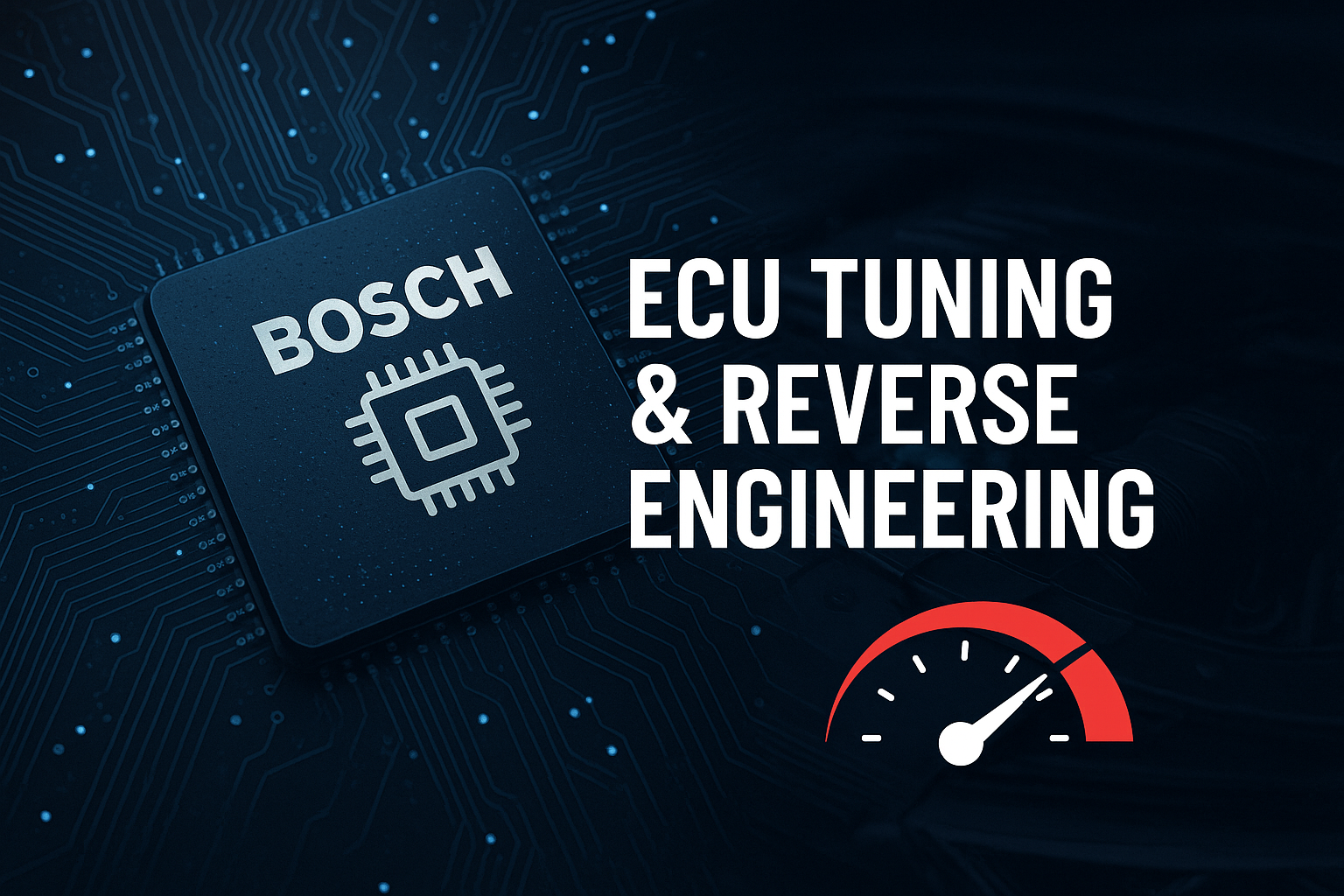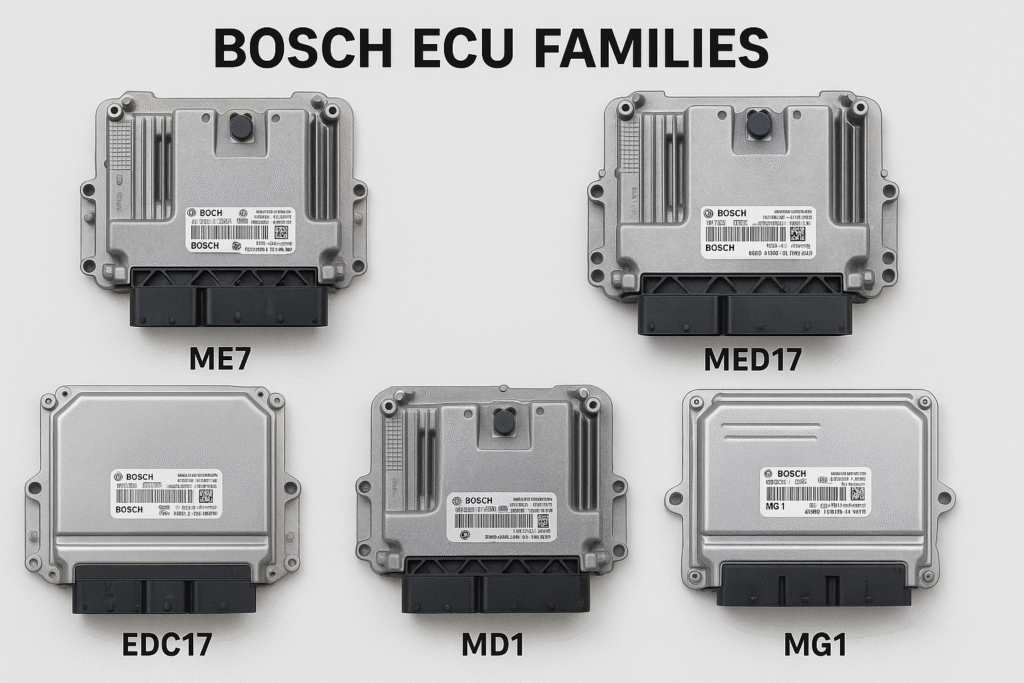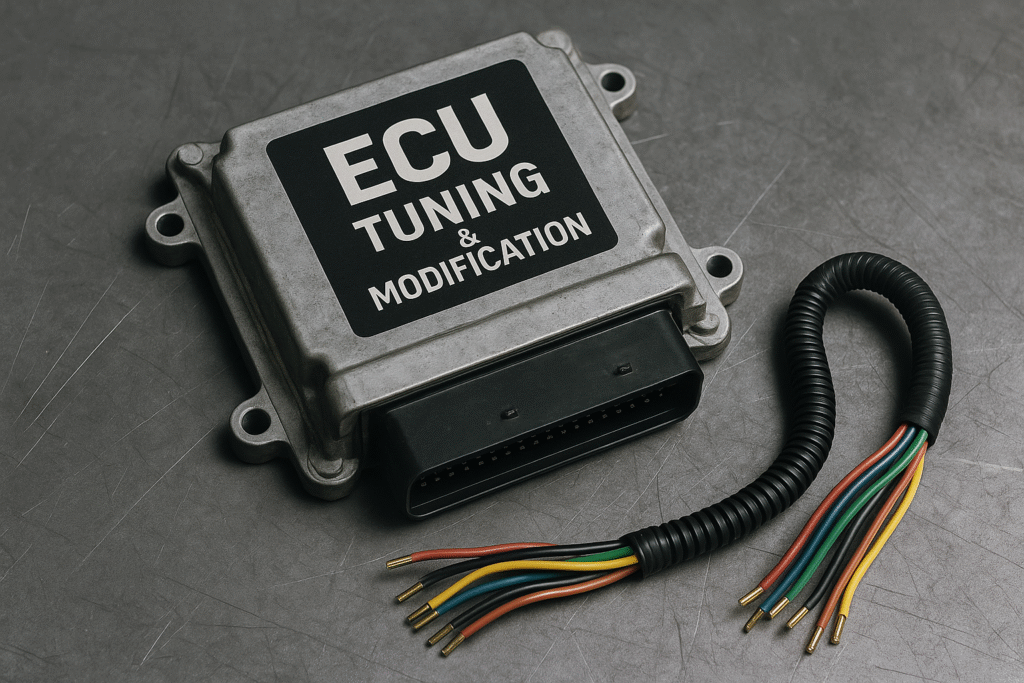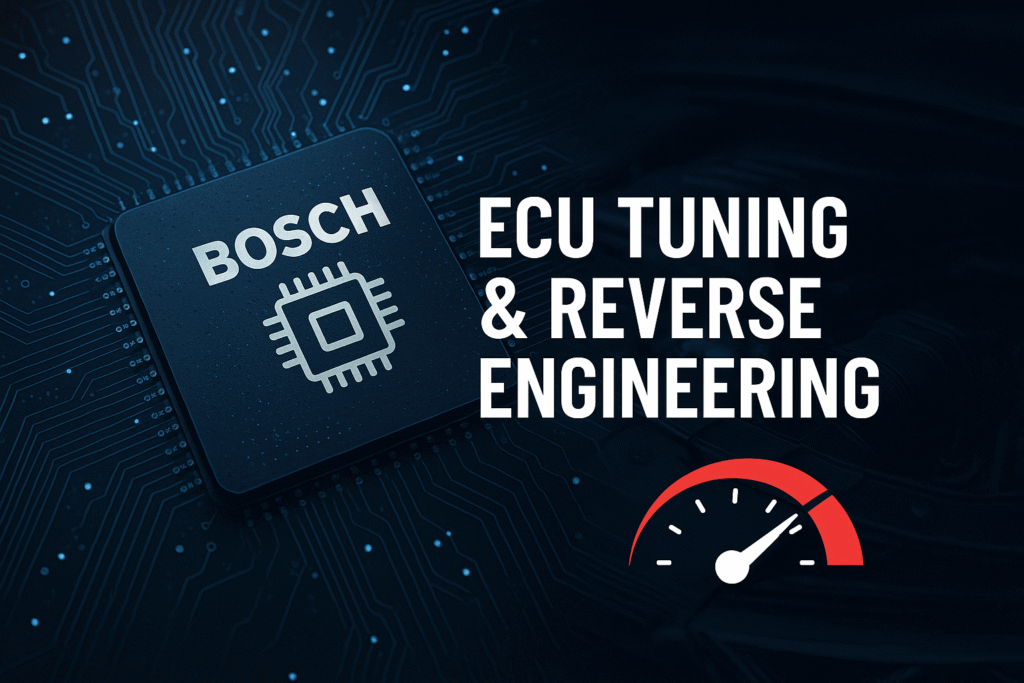
Bosch is one of the leading manufacturers of Engine Control Units (ECUs), and their ME7, MED17, EDC17, MD1, and MG1 platforms are widely used in modern cars. These ECUs control crucial engine functions and have become popular targets for tuning and reverse engineering. Our ECU tuners and reverse engineers have unlocked a range of features on Bosch ECUs from performance enhancements like launch control and boost-by-gear, to functional tweaks like immobilizer delete and checksum bypass. In this article, we’ll deep-dive into each Bosch ECU family and explore the high-demand tuning topics (like launch control, immobilizer delete, stage 1/2/3 tunes, boost by gear, map switching, checksum, and more) that many car tuners search for.
Overview of Bosch ECU Families (ME7, MED17, EDC17, MD1, MG1)
Before diving into specific mods, it’s important to understand the Bosch ECU generations. Each generation introduced new capabilities and new challenges for tuners.

Bosch ECU Families (ME7, MED17, EDC17, MD1, MG1)Below is a quick overview of these popular Bosch ECUs:
- Bosch ME7: An older generation “Motronic” ECU from the late 1990s to mid-2000s used on many gasoline engines (e.g. VW/Audi 1.8T, early 2000s models). ME7 was one of the first fully electronic throttle ECUs and uses a torque-based control strategy. It’s well-known in the tuning community for being hackable enthusiasts have developed tools and code modifications for ME7 to add features like launch control and no-lift shift. Its relatively simpler architecture (compared to later models) made it a training ground for ECU Reverse Engineering.
- Bosch MED17: Part of the Bosch “EDC/MED 17” generation introduced around 2006–2008 for gasoline direct injection engines. The MED stands for Motronic Electronic Direct injection, and these ECUs run on Infineon TriCore processors with advanced features and anti-tuning protections. MED17 ECUs are found in many turbocharged petrol cars of the late 2000s and 2010s (VW/Audi TFSI engines, etc.). They have more complex memory layouts and often include internal encryption or tuning protection, but tuners have still managed to crack them for remapping and even custom code features. Bosch also produced MEV17 and variations for specific manufacturers, but generally MED17 refers to this generation of gas ECUs.
- Bosch EDC17: The diesel counterpart to MED17 and EDC means for Electronic Diesel Control. EDC17 ECUs are used in common-rail diesel engines from roughly the same period (late 2000s through mid-2010s). They control high-pressure fuel injection and manage emissions systems like EGR and DPF filters. EDC17 units also run on TriCore processors and have similar security to MED17. Tuners frequently work with EDC17 for both performance (power/torque gains) and solutions like DPF/EGR delete to resolve clogging issues or to unlock more power. Like MED17, they often require boot-mode or bench reading for initial access due to encryption. Despite that, they are a staple in diesel tuning because disabling emissions restrictions can yield significant gains (15–25% power increase and better fuel economy in some cases).
- Bosch MD1: Introduced around 2016, the MD1 is Bosch’s next-gen ECU family for Diesel engines, replacing the EDC17 series. “MD” stands for Motronic Diesel and these ECUs support the latest technologies (they are extremely powerful, able to handle up to 24-cylinder engines and even 48V systems in heavy-duty applications). MD1 ECUs are used by many manufacturers (BMW, VW, Ford, etc.) and carry even more integration – for example, certain BMW MD1 units also manage functions beyond the engine, like storing immobilizer data or even navigation system codes. Tuning MD1 is possible, but starting in mid-2020 Bosch implemented new bootloader security that can lock these ECUs from being read or written with usual tools. This means very new MD1-controlled cars might require a one-time hardware unlock or workaround from specialized services to enable tuning access. Once unlocked, tuners can perform similar modifications (power tuning, DPF off, etc.) as with EDC17.
- Bosch MG1: The gasoline equivalent of MD1, MG1 ECUs also debuted around 2016 as the successor to MED17. “MG” stands for Motronic Gasoline, and these units are found in modern direct-injection petrol engines (including high-performance models). They share the advanced architecture and security of MD1 (in fact, MD1/MG1 are often collectively referred to as Bosch MDG1 family). Car makers quickly adopted MG1 for its processing power and versatility for instance, it’s used in everything from a Ford Focus to a Lamborghini. As with MD1, newer MG1 ECUs introduced after 2020 can be factory-locked by an updated Bosch bootloader to prevent tuning. Tuning companies have since developed solutions (bench unlocks, signing methods) to deal with this, allowing calibrations and code changes on MG1. In theory, these MD1/MG1 ECUs are Bosch’s most advanced and “versatile” ECUs ever, so virtually any feature that was possible on earlier ECUs can eventually be implemented here it just takes more effort to bypass the protections.
Popular Tuning & Modification Features on Bosch ECUs
Next, we’ll explore the specific features and modifications that enthusiasts commonly pursue through tuning or reverse engineering these ECUs.

Launch Control (2-Step Rev Limiter)
Launch control is a feature that maintains the engine at a specific RPM when the vehicle is stationary, enabling optimal acceleration from a standstill. In practice, launch control operates like a secondary rev limiter (often called a two stage rev limiter) that activates when the vehicle is at zero speed (and often when the clutch is depressed on manual transmissions). This allows the driver to fully depress the accelerator pedal at the starting line without having to freely rev the engine to redline. The ECU limits the RPM (and can also adjust the ignition timing) to generate power and release maximum torque at takeoff.
Many high-performance vehicles are equipped with launch control, but tuning companies often implement or improve this feature on ECUs that don’t initially support it. For example, Tuning Companies have developed special codes for Bosch MED17 and ME7 ECUs to add launch control where it’s not standard. The result is faster 0-60 acceleration and an exciting racing start.
No-Lift Shift (Flat Foot Shifting)
Often paired with launch control is No-Lift Shift (NLS), also known as flat foot shifting. This feature lets the driver keep the accelerator pedal fully depressed during gear changes (on manual transmission cars) without lifting off, and the ECU will momentarily cut ignition or fuel to allow the shift. The advantage is maintaining turbo boost between gears and reducing shift times, effectively improving acceleration during roll racing or track use.
Boost by Gear (Per-gear boost)
Per-gear boost is a tuning strategy (especially for turbocharged vehicles) in which the ECU limits or adjusts turbo boost pressure based on the current gear. The primary goal is to improve traction in lower gears; for example, reducing boost, and therefore torque, in 1st and 2nd gears to prevent wheel spin, while allowing more boost in 3rd or 4th gear, where traction is better. Some factory ECUs have per-gear boost or torque management built in, particularly in high-torque diesel trucks or performance vehicles. However, where it’s not available, our tuners can implement it by creatively exploiting existing ECU inputs or with custom code.
For example, on a Bosch ECU that doesn’t natively support gear-dependent maps, a tuner can repurpose a sensor input or use the vehicle speed signal to create gear-based boost limiting logic. The result is improved power delivery and drivability; the vehicle can launch without straining the tires and then gradually use full power in higher gears. This mode is popular with high-powered front-wheel-drive vehicles or any system where traction is a limiting factor. By adjusting the power increase per gear, you maximize acceleration in each gear without constantly spinning the wheels.
Map Switching (Multiple Tune Maps)
Map switching (also called multi-map or program switching) allows the ECU to hold multiple calibration sets maps and switch between them on the fly.
This means you could have, for example, a “Stage 1” mild tune and a “Race” tune, and toggle between them using a trigger like the cruise control buttons or a specific pedal sequence.
Bosch ME7 ECUs in older Audis actually had commercial solutions like APR’s EMCS that let users switch programs (stock vs performance). For newer ECUs like MED17 and MG1, tuners have developed custom map-switch patches due to high demand. A popular method is using an unused input (e.g., pressing the rear defrost button or tapping the cruise control stalk) to signal the ECU to swap to a different set of fuel, ignition, and boost tables. The ability to switch maps is useful for running different fuel types (91 octane vs E85 ethanol), valet mode (reduced power), or enabling a popcorn mode vs quiet mode on demand.
Some advanced solutions even enable on-the-fly map switching without cycling the ignition. Implementing map switching on Bosch ECUs requires in-depth reverse engineering essentially adding to the ECU’s firmware but it has been achieved on platforms like MED17 and even EDC15/EDC17 in the aftermarket. For the end user, it provides tremendous flexibility (multiple tunes in one ECU) at the press of a button.
Stage 1, Stage 2, Stage 3 Tuning
When researching ECU tuning, you’ll frequently see packages labeled Stage 1, Stage 2, or Stage 3. These terms describe increasing levels of engine modification and tune aggressiveness:
- Stage 1 usually refers to an ECU remap on an otherwise stock car (no hardware changes). The ECU’s factory maps for fuel, ignition, boost, etc., are optimized within safe limits. Stage 1 tunes on turbo engines often yield about a 10–30% power increase just from software. They stay within the capacity of stock components and maintain reliability. For example, a Stage 1 tune on a Bosch MED17 ECU might raise boost pressure and refine fuel timing, giving a noticeable bump in horsepower and torque without requiring any upgrades.
- Stage 2 typically involves an ECU remap plus supporting hardware upgrades like a high-flow exhaust (downpipe), improved intake, or intercooler. The Stage 2 ECU calibration takes advantage of these parts for instance, allowing more boost and fuel since a better intercooler keeps charge temps down, or disabling the catalytic converter monitoring if a catless downpipe is installed. On turbo cars, Stage 2 can achieve roughly 30–50% more power over stock when combined with the right parts. A Bosch EDC17 diesel at Stage 2 might have the DPF filter removed and a freer exhaust, requiring the tuner to disable DPF-related codes and increase fueling accordingly. It’s a more aggressive tune that pushes the car closer to its mechanical limits.
- Stage 3 implies even more extreme modifications often a bigger turbocharger, upgraded fuel injectors or pump, strengthened engine internals, etc., along with a fully custom tune. At this level, the ECU (be it ME7, MED17, or MG1) is calibrated for substantially higher airflow and fuel flow. Gains of 50–100% or more over stock are possible with Stage 3 setups. For example, a Stage 3 Bosch MED17 tune on a 2.0 TFSI might involve a larger turbo and new maps for boost control, fueling, and timing to target double the stock horsepower. Stage 3 tuning often requires disabling or repurposing certain stock ECU functions (like re-scaling sensor ranges, turning off overboost safety limits, etc.) because the car is operating outside its original envelope. Bosch ECUs are highly capable tuners have managed to get astonishing performance from them at Stage 3 but it definitely moves into the realm of expert calibration and engine fortification.
These stages are informal labels, but they are highly searched keywords among car enthusiasts. They help customers understand what level of tune they’re getting. Importantly, as you go up stages, ensuring proper checksum correction in the ECU files and respecting the ECU’s safety checks becomes critical (to avoid errors or engine damage). We’ll discuss checksum shortly, but remember: a Stage 2 or 3 tune on a Bosch ECU often involves things like removing speed limiters, raising rev limiters, disabling emissions monitors, and other complex changes beyond just adding fuel and boost.
Immobilizer Delete (IMMO Off)
Modern Bosch ECUs include an immobilizer system that prevents the engine from running unless the correct key (transponder) is present. In cases of engine swaps, ECU swaps, or lost keys, tuners might perform an “immobilizer delete”, also known as immo off. This means altering the ECU software so that it no longer looks for the immobilizer signal the engine will start and run regardless of the coded key. Immobilizer delete is a common request particularly for swapping a Bosch ECU into another car or when the matching immobilizer unit is faulty.
For example, if you put a used Bosch MED17 ECU into another vehicle, immo off ensures the new ECU doesn’t shut the engine off due to a key mismatch. From a technical perspective, deactivation is achieved by identifying and modifying the section of the ECU firmware that controls the immobilizer codes (sometimes replacing them with valid values).
For car enthusiasts, deactivation is useful when performing independent engine starts (for example, starting an engine without the stock key on a test bench or in a race car). Bosch EDC17 ECUs, in particular, are frequently deactivation for diesel engine swaps in older cars. This modification doesn’t improve performance, but it’s a popular topic in ECU hacking because it can salvage a vehicle that would otherwise be destroyed or facilitate engine replacement.
DPF/EGR Delete (Emissions Removal)
Specific to diesel ECUs, disabling these emissions systems improves performance and reliability (for off-road or motorsport use).
Pops and Bangs (Exhaust Crackle Tune)
Adjusting ignition timing and fueling can create exhaust crackles on deceleration, adding an aggressive sound profile.
Checksum Correction and Tuning Protection
Any ECU modification must include proper checksum correction to ensure the ECU accepts the changes. Modern ECUs also use advanced digital signatures and encryption, requiring special unlocks for tuning.
Bosch ECU Tuning Guide: Unlocking ME7, MED17/EDC17, MD1 & MG1 Performance and Features

Bosch ECUs like the ME7, MED17, EDC17, MD1, and MG1 have proven to be fertile ground for tuners and engineers. Through years of reverse engineering efforts, the community has unlocked almost every possibility: from straightforward power increases via Stage 1/2/3 calibrations to creative features like launch control, no-lift shift, boost-by-gear, and switchable maps. Additionally, solutions for practical needs immobilizer deletes for engine swaps, DPF/EGR removals for off-road diesel builds, and overcoming checksum/lockout hurdles are all part of the Bosch ECU tuning landscape.
Each successive generation of Bosch ECU has become more sophisticated, but the tuning industry has kept pace. The MED17/EDC17 era introduced challenges like encrypted firmware, yet now it’s routine to tune them for big gains and add fun features (for example, an Audi MED17 ECU can be coded for crackle and pops or multiple boost maps). The latest MD1/MG1 ECUs raised the bar with immense capability and new security, and tuners are already delivering tunes for these as well – proving that where there’s a will, there’s a way. As Bosch ECUs continue to evolve, so do the tools and techniques for customization.
For car enthusiasts and professionals alike, understanding what’s possible with Bosch ECUs is both exciting and empowering. Whether you want a burbling exhaust on your Volkswagen GTI (Bosch MG1), a torque-rich tune on your BMW diesel (Bosch MD1), or to simply keep an older project car running with an immo-off hack, the knowledge is out there. Always remember to use reputable sources and methods – incorrect modifications can cause serious engine issues. But when done right, Bosch ECU tuning can transform a vehicle’s character.
In summary, Bosch ECU platforms offer a playground for tuning: you can improve performance with staged remaps, add motorsport-inspired functions, or remove unwanted restrictions. By leveraging the collective expertise of the tuning community (and observing the necessary precautions like checksum correction), even complex tasks like map switching or launch control on these ECUs are achievable. The result is that today’s tuners can extract the full potential of a vehicle, far beyond what the stock parameters allow, all thanks to the versatile and hackable nature of Bosch engine computers.
Bosch ECU tuning and reverse engineering is a continually evolving field but the high-demand topics covered above remain at its core. If you’re venturing into this hobby or profession, focus on the fundamentals of your ECU type, learn from community resources, and never stop experimenting (safely!). The possibilities with Bosch ME7, MED17/EDC17, and MD1/MG1 ECUs are vast, and with the right approach, you can truly unlock a new level of performance and functionality in your car.
At ReverseEngineer.net, we specialize in unlocking the full potential of Bosch ECUs — from ME7 and MED17 to the latest MD1/MG1 platforms. Whether you need performance remaps (Stage 1, 2, or 3), advanced features like launch control, map switching, boost-by-gear, or solutions such as immobilizer delete and DPF/EGR removal, our team of experienced reverse engineers delivers tailored solutions with precision and reliability.
If you’re ready to take your vehicle to the next level or need a custom ECU solution, contact us at ReverseEngineer.net today and let’s bring your project to life.
Let's Work Together
Need Professional Assistance with Reverse Engineering or Cybersecurity Solutions? Our Team is Ready To Help You Tackle Complex Technical Challenges.